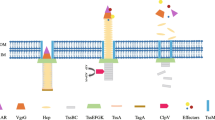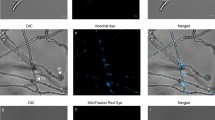Abstract
The pr1 gene of the entomopathogenic fungus Metarhizium anisopliae encodes a serine protease that is highly active towards the insect cuticle and whose synthesis is subject to both carbon and nitrogen repression. The pr1 promoter region was sequenced revealing the presence of putative CREA- and AREA-binding sites. In vitro bandshift experiments demonstrated that an Aspergillus nidulans GST-CREA fusion protein was capable of binding to two of the three putative CREA sites. Using a PCR-based strategy the M. anisopliae crr1 gene was identified; it encodes a putative C2H2-type DNA-binding protein with significant sequence similarity to A. nidulans CREA. Complementation experiments with an A. nidulans strain carrying creA204 demonstrated that CRR1 can partially substitute for CREA function.
Similar content being viewed by others
Author information
Authors and Affiliations
Additional information
Received: 29 November 1996 / 4 February 1997
Rights and permissions
About this article
Cite this article
Screen, S., Bailey, A., Charnley, K. et al. Carbon regulation of the cuticle-degrading enzyme PR1 from Metarhizium anisopliae may involve a trans-acting DNA-binding protein CRR1, a functional equivalent of the Aspergillus nidulans CREA protein. Curr Genet 31, 511–518 (1997). https://doi.org/10.1007/s002940050238
Issue Date:
DOI: https://doi.org/10.1007/s002940050238




